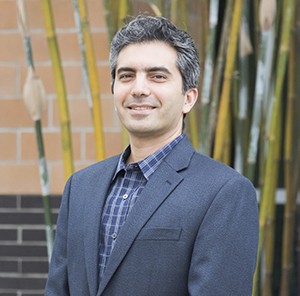Reza Abdolvand on His Advances in MEMS Technology
December 7, 2015
 Reza Abdolvand, Ph.D., Associate Professor and Director of the Dynamic Microsystems Lab in the College of Electrical Engineering and Computer Science (CECS), always knew he would build things when he grew up. Little did he know that one day he would engineer and construct complex devices that were about the size of a grain of salt. This realization didn’t occur until 2002, when he began his doctoral studies at Georgia Tech as a doctoral student in electrical engineering and was introduced to MEMS technology: micro-electro-mechanical systems. Abdolvand gave a brief primer on this field.
Reza Abdolvand, Ph.D., Associate Professor and Director of the Dynamic Microsystems Lab in the College of Electrical Engineering and Computer Science (CECS), always knew he would build things when he grew up. Little did he know that one day he would engineer and construct complex devices that were about the size of a grain of salt. This realization didn’t occur until 2002, when he began his doctoral studies at Georgia Tech as a doctoral student in electrical engineering and was introduced to MEMS technology: micro-electro-mechanical systems. Abdolvand gave a brief primer on this field.
“What researchers in the field of MEMS are trying to accomplish is to take systems that are electromechanical in nature — meaning that they include both electrical and mechanical components — and make them smaller in size, using the technology that has been developed for microelectronic devices,” Abdolvand explained.
He further explained that the field of microelectronics created integrated circuits (ICs), and decades of work and research went into developing processes to mass produce ICs at very small scales. Researchers and engineers pondered if the same, well-established processes that were used to create microelectronics could be utilized with creating electromechanical components—and this postulation proved to be true. By using existing knowledge and methods to create new types of devices, MEMS products are relatively inexpensive to manufacture.
The specific type of MEMS that Abdolvand focused on at Georgia Tech, and then at Oklahoma State University as an Assistant Professor and Associate Professor, were mainly MEMS resonators—small structures that vibrate at high frequencies and can be used for a variety of applications including sensing.
—
There are many different types of sensors. Abdolvand described how the general technological trend of moving towards a wireless world affects the field of sensors:
“Everyone is trying to make wireless sensors now because of the ease of implementation, the simplicity, and the flexibility that comes with a wireless system. With passive wireless sensors, the sensor itself does not have a source of energy on-board, meaning that the sensor is scavenging off of the energy that will be received wirelessly, as opposed to carrying a source of energy, like a battery. What we are developing is a special type of passive wireless sensor in which the device is not really converting the incoming energy into a source of energy to run any processing or to power any electronics. Rather, it just reflects the energy back. So it’s more like a reflector of energy.”
And this isn’t a novel idea. Abdolvand credited Donald Malocha, Ph.D., Professor in the CECS and the Director of the Consortium for Applied Acoustoelectronics Technology (CAAT) for his pioneering work in this field using SAW (surface acoustic wave) devices. But, just as the MEMS field built on what the microelectronics field created, Abdolvand’s work has a similar streak of ingenuity.
“What’s new in our technology is that we’re trying to use MEMS to make those type of devices,” Abdolvand said. The ability to create sensors that could possibly not be seen with the naked eye leaves Abdolvand in constant amazement.
“To be able to capture that tiny amount of energy and turn it into useful information, that always amazes me. It doesn’t matter how many times I see it. The signal is weak, and yet you can extract information from meters away,” he said.
Because of their small size, these sensors can be used in a variety of ways, including monitoring the health of a patient, potentially replacing many wired sensors for wireless ones. He is currently working on making these devices even smaller by reducing the size of the antenna as well as optimizing the sensing element.
Constructing such intricate, infinitesimal devices requires some dogged determination as a researcher and engineer—facing constant failure and yet continuing with the work. Abdolvand thrives on being challenged: “When things are hard to do, that motivates me to do them.”
His fortitude is fueled when he is able to envision an end product with his efforts. As an engineer, Abdolvand enjoys building products that might one day end up in the marketplace, and he appreciates how UCF values research that is also valued by industry—something that isn’t found in all universities. Abdolvand remarked, “From day one, when I interviewed at UCF, they seemed to be pretty proactive with engaging with industry. And so far, that has been the case.”
Joining UCF in the spring of 2014, Abdolvand has valued the facilities support, how quickly he was able to set up his lab, engaging with his colleagues, and the support he received from UCF leaders including his department chair, Zhihua Qu, Ph.D., Michael Georgiopoulos, Ph.D., the Dean of CECS, MJ Solieau, Ph.D., Vice President of Research & Commercialization, and Sudipta Seal, Ph.D., Director of Advanced Material, Process, and Analysis Center (AMPAC) and the NanoScience Technology Center (NSTC). Although he hasn’t been at UCF long, Abdolvand has hit the ground running with his research, spurred on by a big fascination of microsystems that we can barely see or perceive.
—
Through creativity, determination, and collaboration, Abdolvand has created a device that could revolutionize the field of sensors. To learn more about these passive wireless sensors with MEMS resonators, contact Raju Nagaiah, Ph.D. for more information.